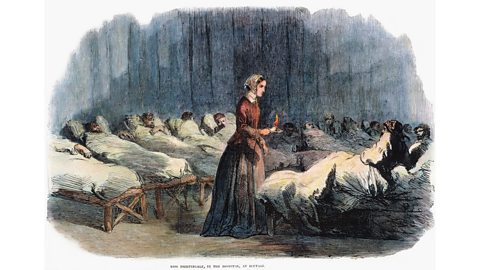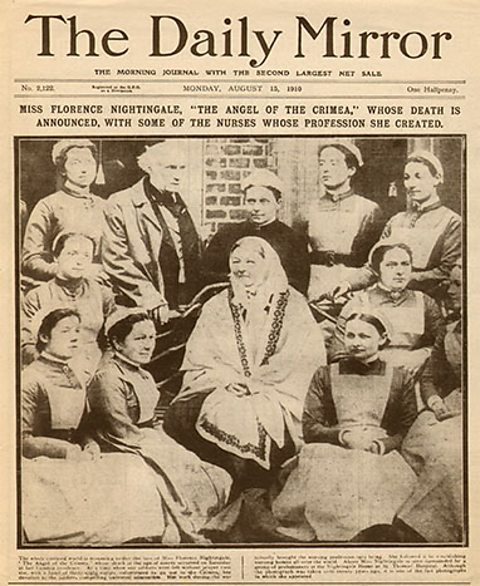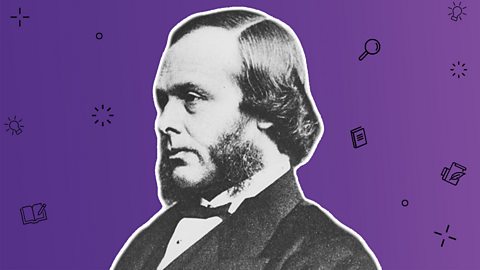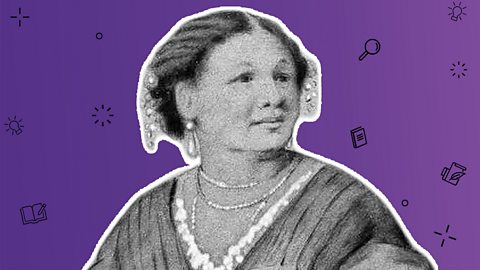Key points

- Before the 1800s, there was no official training for nurses - they learned from family or other nurses. Nursing often relied on natural treatments.
- In the 1800s, attitudes to nursing changed and it began to be considered a profession. Official training and nursing colleges were set up.
- Florence Nightingale nursed soldiers during the Crimean War and made a lasting impact on the nursing profession.

Who was Florence Nightingale?
Florence Nightingale was born in 1820. She was named after the Italian city Florence, where she was born.
She grew up in England in a wealthy family. Her familyâs wealth and her parentsâ attitude to girlsâ education meant that she and her sister were well educated - which was unusual for the time. She studied a variety of subjects, including history, mathematics, languages and literature.
Nightingale wished to become a nurse but her family disapproved. At the time it was rare for wealthy women to work, especially in a job that was widely thought to be for people in a lower social class. There was also an expectation, within society, that wealthy women should get married and have children.
At the time most nurses received no formal training but Nightingale did receive some training. In 1844 when she enrolled as a nursing student in a hospital in Germany. After this, Nightingale returned to England. She took a nursing job in a hospital, where she worked to improve the unsanitaryA state of poor hygiene conditions which leads to an increased risk of the spread of disease. conditions.
In 1853, while Florence Nightingale was working in a hospital on Harley Street in London, a journalist from The Times newspaper, William Howard Russell, wrote reports about conditions the soldiers faced during the Crimean War.
He wrote, âthere is no attention paid to decency or cleanliness, the smell is appalling.â
In another report he said, âAre there no devoted women among us, able and willing to go forth and minister to the sick and suffering soldiers of the East in the hospitals at Scutari?â
Reports like these may have persuaded Nightingale to travel to CrimeaA peninsula connected to the South of mainland Ukraine between the Black Sea and the Sea of Azov. to help wounded soldiers.
Florence Nightingaleâs work during the Crimean War
In November 1854, Florence Nightingale arrived in Scutari on the Black Sea, which is in modern-day Turkey. She arrived with a group of 38 nurses from England ready to help the British soldiers who were fighting in CrimeaA peninsula connected to the South of mainland Ukraine between the Black Sea and the Sea of Azov.. Britain was at war with Russia for control of the Ottoman EmpireThe Ottoman Empire was an empire that controlled large areas of southeastern Europe, western Asia and north Africa from the 1300s to the early 1900s. It was founded in the north-west of modern-day Turkey. in a conflict that lasted from 1853 - 1856. This conflict was called the Crimean War.
Some historians believe Nightingale was personally asked to go to improve nursing for the wounded soldiers by the Secretary of State for War at the time, Sidney Herbert. Nightingale had been friends with Herbert for several years. Nursing wasnât a highly regarded career in the early 1800s:
- Pay in hospitals was low. For example, in Manchester, wages received by workers in cotton mills were higher than those paid to nurses.
- Many nurses were illiterate.
- Nurses who worked in workhouses often had no training and were not paid.
Nightingale wrote to Herbert from Crimea saying she wanted more trained nurses to be sent to help her, and not people who lacked the professionalism of the original team she had brought with her.
What were the conditions like at Scutari Hospital?
When Nightingale and her nurses arrived at the hospital in Scutari, they found:
- Staff who were tired from working long hours and therefore not able to care for patients properly
- Not an adequate number of nurses to treat the wounded soldiers
- A shortage of beds
- Unclean and unhygienic conditions in which to treat patients
- A lack of medicines to treat soldiersâ wounds
- Poor sanitation. The Scutari hospital was built over poorly maintained sewers. This meant raw sewage leaked into the hospital.
Also, the conditions in which the soldiers lay were making their injuries worse. Nightingale found that wounds were exposed, with no adequate dressings to prevent infection. There were accounts of flies landing on wounds. It was noted that bed sheets and other surfaces had lice and maggots on them. Diseases like typhusAn infectious disease spread by lice. It causes a fever and can be fatal. and choleraA disease that causes infection of the intestine. It is normally spread through contaminated water. were widespread in the hospital.
In 1855, the British government ordered a report to be produced on the conditions wounded soldiers faced in the Crimean war.
What did the report say about bedding in the hospital?
The report highlighted that, âThe washing of the bed linen is very badly done there [in Scutari hospital], the sheets which return from the wash are frequently found in a more filthy condition than those which they are intended to replace.â
The report highlighted several other problems, including:
- surgeons having too many patients
- poor quality food being served
- staff were being asked to take on too many different roles
- too many staff were unqualified for the medical roles they were carrying out
What two diseases were common in the hospitals Nightingale and her team went to?
Two common diseases were typhus and cholera.
Nightingale knew this was not an environment in which to nurse people back to health. She focused on cleanliness and hygiene, directing her nurses to scrub and clean the hospital. She insisted that soldiers have clean sheetsthat were changed regularly and that they lay on beds, not on the floor.
Nightingale's work at Scutari Hospital
Nightingale would walk the hospital at night, checking on the soldiers and offering them comfort and care. This earned her the nickname âThe Lady with the Lampâ following a newspaper report in The Times that said,
When all the medical officers have retired for the night, and silence and darkness have settled down upon these miles of prostrate sick, she may be observed alone, with a little lamp in her hand, making her solitary rounds.

Florence Nightingale's use of statistics
Florence Nightingale also devised a way to record and compare information on casualties and the impact of poor hospital conditions. This was called a rose diagram and is similar to a pie chart. This method has since been used by other statisticians to compare data.
What was the result of Nightingaleâs work in Crimea?
Nightingale insisted that her nurses wash their hands and showed them how to practice nursing in a hygienic way. Over the course of the war the percentage of soldiers dying fell from 42 per cent to 2 per cent in part due to the work of Nightingale, her nurses and their drive to keep hospitals hygienic.
Historians have debated how much of the reduction in mortality rateThe proportion of people who die from a particular cause in a given population. in the Crimean war was down to her measures. A different interpretation is that the improvements in clean water supply and cleaning out of sewers played a more important role in improving survival rates.
Nightingale was a well-known figure for her role during the Crimean War. Queen Victoria exchanged letters with her, and newspapers reported on her work. She was a high-profile figure in a prominent position who could bring about significant long-term change to the status of the nursing profession when she returned to Britain.
Nightingale after the war
Notes on Nursing
When Florence Nightingale came back from the Crimean War, she wanted to improve the standards of British hospitals. She wanted to make nursing consistent, more professional and ensure that high standards of care were met. Nightingale set out her ideas in a book called Notes on Nursing. This is seen by many historians as setting out some of the key principles in developing the nursing profession.
What ideas did Nightingale encourage people to use in âNotes on Nursingâ?
Nightingale outlined her ideas about effective nursing in her book. For example, this is what she wrote about the importance of observation,
The most important practical lesson that can be given to nurses is to teach them what to observe -how to observe - what symptoms indicate improvement - what the reverse - which are of importance - which are of none - which are the evidence of neglect - and of what kind of neglect. All this is what ought to make part, and an essential part, of the training of every nurse. At present how few there are, either professional or unprofessional, who really know at all whether any sick person they may be with is better or worse.
Training school at St Thomasâ Hospital
In 1860, Nightingale set up a nursing training school at St Thomasâ Hospital in London. Trainee nurses were taught the methods and ideas Nightingale had introduced in CrimeaA peninsula connected to the South of mainland Ukraine between the Black Sea and the Sea of Azov.. This was significant in raising the status and professionalism of nursing.
British hospitals were still facing problems, such as patients dying from infections because doctors were not properly washing their hands or equipment. Patients were catching diseases on wards due to a lack of hygiene.
What did Nightingale and her nurses focus on?
The nurses focused on cleanliness and order. Nightingale was sure that clean bedding, hands and medical equipment would improve the chance of survival and recovery of patients.
By the time Nightingale died in 1910, there were over 60,000 properly trained nurses in Britain. Nursing became a highly skilled and well-respected profession.
Legacy

Florence Nightingale died in 1910, aged 90. Her life and work has been remembered in several ways.
- The nursing school at St Thomasâ Hospital, was named after her, and it is now part of Kings College, London.
- A statue of Nightingale was installed in central London in 1915.
- Seven Nightingale hospitals were set up and named after her during the Covid-19 pandemic to cope with increased patient numbers in the NHS.
- When people in the United States of America qualify as nurses they take the Nightingale Pledge.

Test your knowledge
Play the History Detectives game! gamePlay the History Detectives game!
Analyse and evaluate evidence to uncover some of historyâs burning questions in this game.

More on Science, progress and health
Find out more by working through a topic
- count3 of 4

- count4 of 4

- count1 of 4
